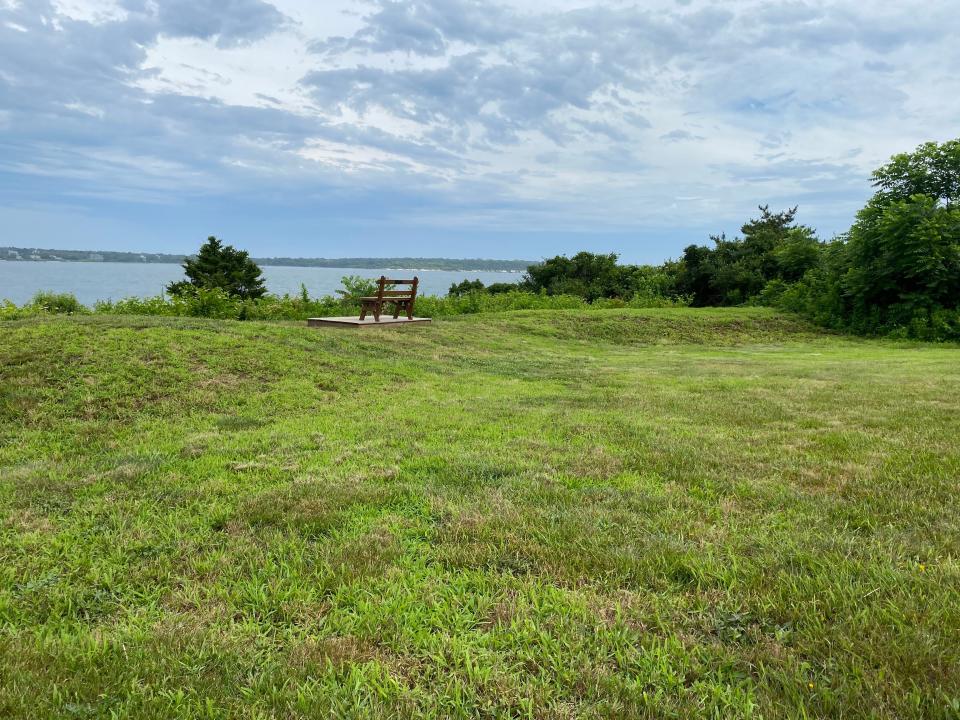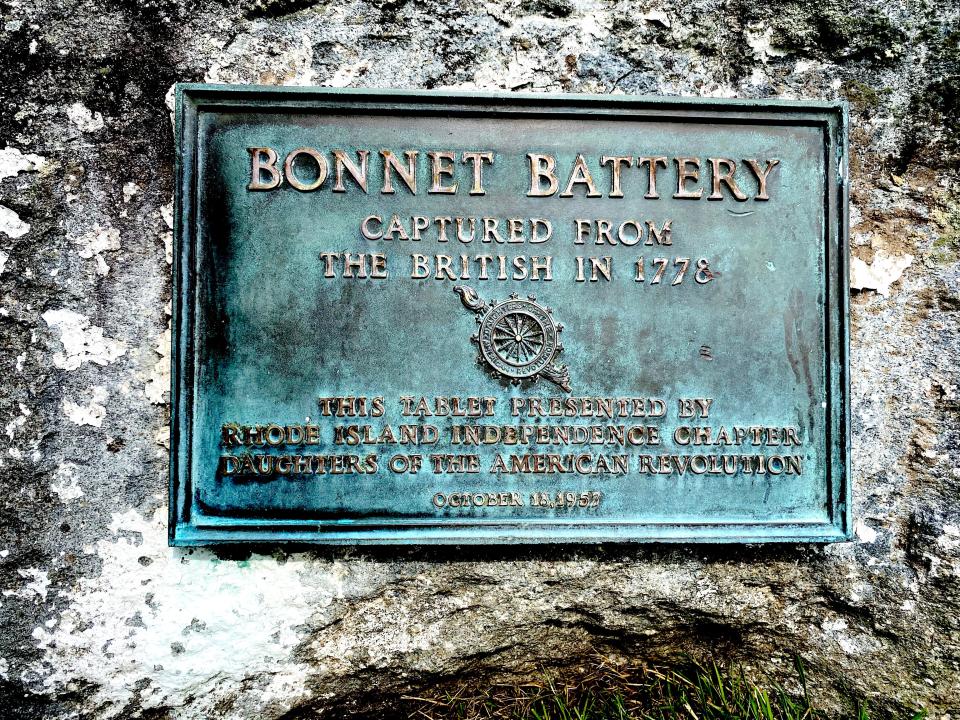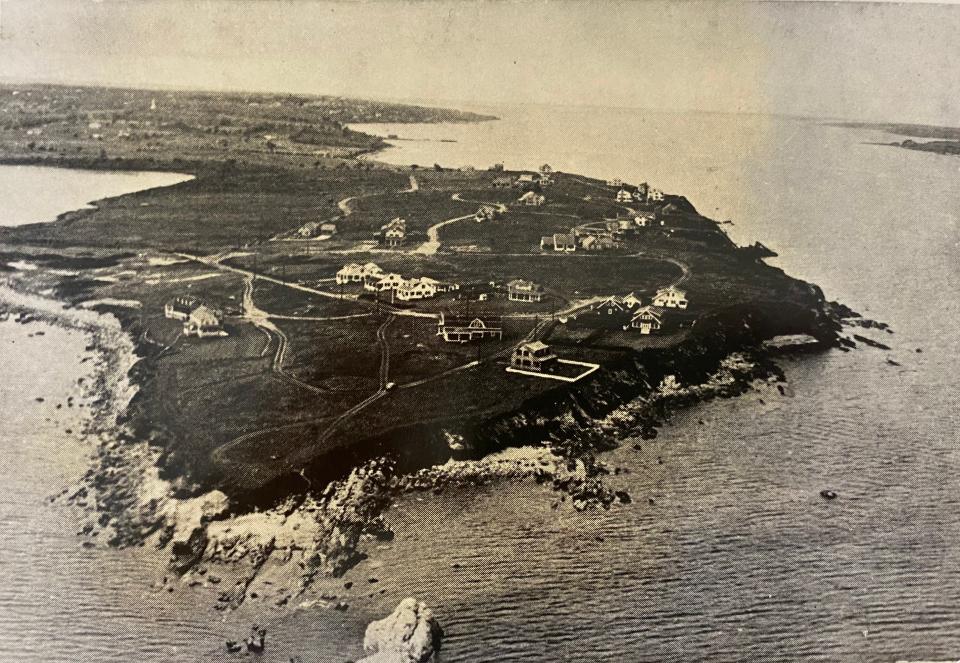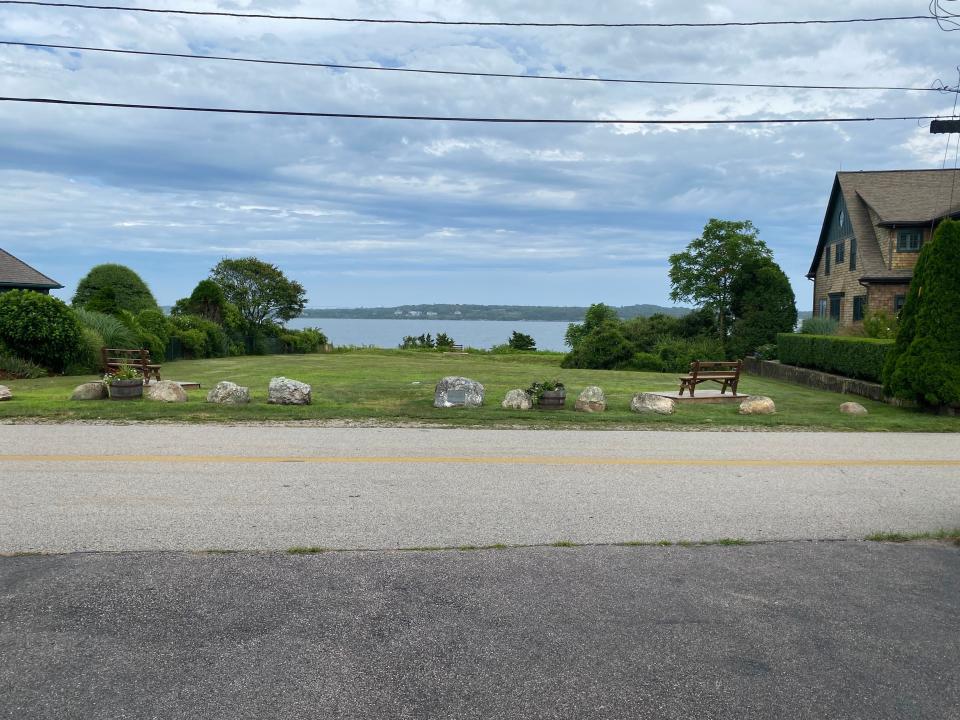Bonnet Shores: More than a beach getaway. Exploring its Revolutionary roots
As the summer moves along, thousands of Rhode Islanders will head for Bonnet Shores in Narragansett to enjoy a day at one of the state’s most popular beaches.
However, very few of them know that “The Bonnet” has a storied military history, dating back to the American Revolution.
Nestled within the densely settled resort community, opposite the house at 251 Col. John Gardner Road, is a small open field measuring about a third of an acre. Passers-by might imagine this is a very expensive house lot, awaiting the construction of a multimillion-dollar home overlooking the ocean.
Not even close. This lot, featuring a grass-covered mound at the edge of a 60-foot cliff, is the site of the remaining earthworks of the Bonnet Battery, built in the early days of the Revolution to guard the West Passage of Narragansett Bay.

According to the Rhode Island Historical Preservation & Heritage Commission, the battery “… along with a battery on Conanicut Island across the bay, guarded the passage. … The battery reportedly once had eight guns.”
Battery site saved from development in the 1950s
Fred Crandall helped develop Bonnet Shores, starting in 1928. In the early 1950s he became convinced of the Bonnet Battery’s historic significance. He prevailed upon the Bonnet Shores Fire District to purchase the land with the intention of protecting it.
The Bonnet Battery dedication took place Oct. 18, 1957, led by a group from the Daughters of the American Revolution. Crandall commissioned a tablet from Gorham Manufacturing to be placed on a boulder at the site. It read, “Captured from the British in July 1778.”
Or was it?

What happened to the HMS Gaspee: First blood of the American Revolution or petty revenge?
Historical background the Bonnet Shores Battery
When a massive British force invaded Aquidneck Island in December 1776, the Royal Navy fleet sailed up the West Passage and around the northern end of Jamestown in order to avoid American fortifications in the East Passage on the approaches to Newport. It is likely that the Bonnet Battery did not exist at that time.
There are conflicting historical reports about what was actually at “The Bonnet” during the Revolution, and when they were erected.

An 1896 text reported, “On Bonnet Point in South Kingstown was an earth work called the Bonnet Battery thrown up in 1777.”
There are also some references to the site hosting a battery during the War of 1812. According to Patrick Carstens in his 2011 history of the War of 1812, “… although the east passage was fortified, the only [protection against] passage into the West Bay was an old battery at Bonnet Point, which was occasionally manned.”
During the Civil War, northern coastal cities were alarmed by the threat of Confederate raiders marauding off the coasts and wreaking havoc with shipping. In June 1863, Rhode Island Gov. James Y. Smith telegraphed President Abraham Lincoln, seeking the authority and federal funds to strengthen the defenses of Narragansett Bay. Permission was immediately granted, and the Bonnet site was selected.
The fortifications were rebuilt, and a battery from the Providence Marine Corps of Artillery was sent from Providence. The only infantry unit left was a group of students from Brown University called the University Cadets. These two units manned the Bonnet Point Battery for several weeks during June and July 1863. (This is a fascinating tale in its own right, which I will cover in next week’s column.)
According to the Historic Preservation Plan of the Rhode Island Statewide Planning program, “… although the battery never saw combat during the Civil War, it remained an important coastal defense.“
Pat Kuehne is a member of the Bonnet Shores Fire District History Committee. She suggests that the Bonnet Battery was permanently decommissioned by 1885.
Tablet that marks Bonnet Battery today may be incorrect
Back to that plaque which marks the battery today.
I respectfully suggest that Fred Crandall and the DAR got it wrong. There is zero evidence to support the contention that the Bonnet Battery site was ever occupied by the British, which means that it could not have been captured from them.
The British occupation stopped at Jamestown. The only documented British military activity west of Jamestown was a handful of British raids primarily seeking cows, sheep and similar supplies.
The Narragansett Historical Society referred me to Richard Vangermeersch, a retired University of Rhode Island professor who has spent 60 years in academic research. He has pursued numerous history projects for the town.
“Murky at best,” is how he describes the assertion on the plaque. “The British could not have occupied that fort, primarily because the site could not be supplied or supported.”

Given their exposed position, a very large garrison would have been required to protect the fort. Furthermore, the British would have had to fortify the landward side to guard against attacks from Rhode Island militia. The half-circle construction facing the sea would have been untenable.
In 2022, the Rhode Island Publications Society published Col. John K. Robertson’s book titled "Revolutionary War Defenses in Rhode Island." Robertson, who lives in Austin, Texas, was kind enough to explain his conclusions about the battery.
He is even more emphatic: “That the Bonnet was a British fort on the mainland is totally absurd. Nothing in British or French records documents a British fort on the main …"
To be fair, back in the 1950s researchers did not have the benefit of the internet and the other incredible research tools we have today. It is possible that Crawford and the DAR conflated the stories about the Bonnet and Conanicut batteries; the fort on Jamestown was captured by the British and was retaken in 1778.

This newspaper compounded the error in 1998 when it reported that the Bonnet Battery had been “overrun by redcoats and held by them until 1778.” The story also stated that the Bonnet and Conanicut batteries were built by the Rhode Island militia in 1775, “but unfortunately for the Colonists, the British overran both sites, holding onto them until 1778.”
An earlier write-up (1919) in the Newport Mercury got it right. Speaking of the battery, they wrote, “It was continuously occupied by Rhode Island troops.”
Fire District today
In 1991 the Bonnet Shores Fire District set up a land trust, and that entity now owns the battery site as well as several other public-use properties. The trust is managed by trustees elected by the community; Mary Flynn is the current chair.
“I fully support taking action to make the battery more visible, and to become more of a community resource of which we can be proud,” Flynn said.

There is a History Committee, chaired by Bonnet Shores Fire District Councilwoman Carolyn DiLeo. DiLeo would like to see a more visible sign identifying the battery site, and perhaps even an informational kiosk.
Flynn supports DiLeo‘s efforts but cautioned, “We can only move forward incrementally. We are constrained by the fact that we are an all-volunteer organization and that our funding is minimal.”
Special thanks go to the Bonnet Shores Fire District, Col. John K. Robertson, and Richard Vangermeersch for their help with this topic. I would also like to acknowledge material provided by the Narragansett Historical Society, especially the 2015 publication “A self-guided tour of coastal gun emplacements in Narragansett, RI” by Kathie Kelleher.
To report the outcome of a previous activity, or to add a future event to our calendar, please email the details (including a contact name and phone number/email address) to veteranscolumn@providencejournal.com.
This article originally appeared on The Providence Journal: Bonnet Battery had major role in Revolution, but was it occupied?

